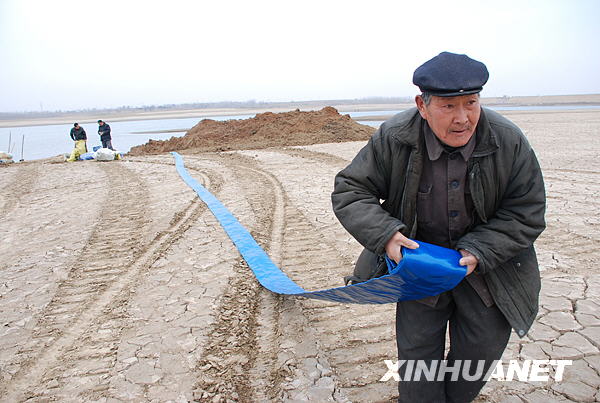There looked to be little relief ahead for farmers in Henan province this week, with experts predicting the severe drought that has starved their crops for more than 120 days will continue.
 |
|
Villagers in Tangyin County, Henan province, channel water into their wheat field on February 15, 2009.
|
Liu Mancang, vice-governor of the province, had felt raindrops on his face as he walked to the office on Saturday. Hoping it signaled the end of the worst dry spell for 60 years, he rushed to call the local meteorological administration.
But the news he received was not good. And at a press conference later that day, Liu, also vice-commander of the drought-relief team covering China's biggest farming region, admitted: "The drought will go on as there isn't going to be enough rain in the near future."
On Feb 7, Henan province had its first rainfall for 110 days - it was just 6 mm. During February and March, a crucial time that can dictate the success of a June harvest, crops needed 30 mm, said Zhu Mengzhou, deputy director of the province's agricultural bureau.
"If the drought continues, we may lose at least 25 percent of the production this year," he added.
And with temperatures rising, the arrival of pests may deteriorate the situation.
"It was reported there would be rainfall around Feb 17 but we are not optimistic it can relieve the huge drought," Yu Hequn, vice-deputy director of Henan's irrigation bureau, told China Daily on Saturday.
The province has spared no expense in attempting to save its 78.9 million mu (5.26 million hectares) in winter wheat, having spent 1.169 billion yuan (US$170 million) of its relief fund to put 1.82 million people on average every day and a total of 620,000 vehicles into action.
Wheat fields in central plain areas, especially those near water resources such as reservoirs, aqueducts, rivers and wells, have been irrigated effectively. But the 28 million mu in the western uplands has been difficult to reach.
"We endeavor to dig wells, divert water from rivers and organize people to transport water to relieve the drought," said Yu. But of the 9 million-plus mu that cannot be helped, he explained: "The cost is too much. The irrigation facilities, most built in 1960s, are out of order. Farmers have nothing to do but rely on rain."
The drought also revealed cracks in the current farming system, he said.
"It is too expensive to adopt the advanced irrigation technology for individual households," Yu told China Daily.
He said he hoped the country's new land transfer policy will speed up the process of large-scale planting and mass production, which would enable more effective farming management and save a vast cost.
On Saturday afternoon, Qu Deqi finally saw a fire engine arrive to water his 10 mu of fields.
The 60-year-old farmer in Wanggang village, Zhenping county, had been worrying for two months. His two sons went out to work but the wheat production still took up a third of his total annual family income.
"Many seeds have died in the drought but, as long as my wheat receives enough water, the loss could be acceptable," he said.
Qu also planted some rapeseed but the thirsty crops have all died because there was no water resource near his fields.
And Qu said rain was still needed as the water from the fire engine could only protect the seeds for a short while.